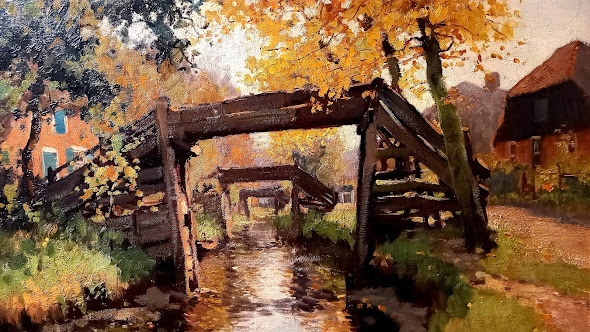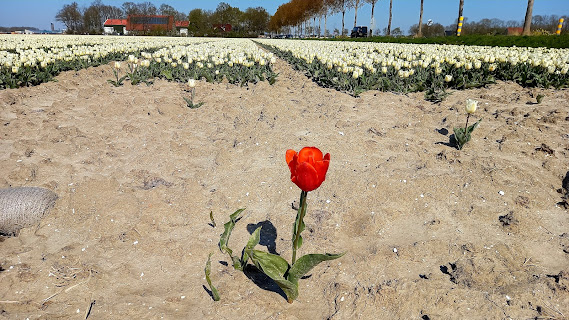Visiting Overijssel - Kampen, Waterloopbos and Giethoorn
This trip has been 4 years in the making.
When arriving in NL one of the first places we were told to visit was Giethoorn. So 4 years later we planned a 2-day trip, booked a hotel, and off we went!
**********
Our trip mainly took place in the region of Overijssel, which is right next to the Flevoland region where we travelled recently (see this post).
We took an early train to Kampen with our 2 foldable bikes (yes we now have 2 - we bought a second-hand one, fixed it up ourselves after 3 mechanics refused to touch it, and it works (almost) fine!), and arrived before 10am.
Kampen is so beautiful. The buildings are very old but in amazing shape, and you need to stop yourself from taking a picture of each one of them. The city used to be a very important port city for the Netherlands and for the Hanseatic League (uniting the most important ports of north Europe), but since the reclaimed land of Flevoland was created, it cut off its access to the sea and it lost its importance.
However you can still see beautiful boats in its harbor, and the city shows signs of old wealth at every corner.
We stopped for a cappuccino and cake, and made a bold choice with a cake looking exactly like pink sponge. It turned out delicious, of course :)
After a quick walk around town and vowing to return for a proper visit, we got back on the bikes for the ride to the Waterloopbos, where a type of sculpture built on water intrigued us, so we had to go see.
**********
The ride was so typically Dutch, with flat fields, farmers, and cows.
We stopped on the way for lunch, unwrapping our DELICIOUS sandwiches (which we made ourselves - grilled eggplant, hummus, walnuts and halloumi - the best ever) with a side of warm strawberries.
We had a quick chat with a lonely farmer who jumped at the opportunity to talk to *anyone*, and who gave us some very depressing statistics on the life and well-being of farmers in this country (30% are leaving for other countries due to new environmental rules being implemented, and a lack of recognition). We did not understand much, as his English was about as good as our Dutch, but the phrase to remember was "No farmers, no food!".
We arrived at the sculpture, named "Deltawerk//" by RAAAF | Atelier de Lyon, which is actually not a sculpture at all.
It turns out that this area was used in order to make tests regarding the effect of the waves on concrete buildings. The whole structure was actually below the ground, but when it was abandoned, designers decided to raise it above ground to showcase the legendary battle of the Dutch against the water.
"RAAAF and Atelier de Lyon have excavated the colossal wave basin, so that the concrete tank now towers about seven meters above you. This colossal delta work-to-scale now stands in a tranquil water surface. The devastating power of the water is made tangible because the artists sawed, turned and tilted large blocks from the concrete walls. A rhythm of falling plates is created. When you walk over the two new bridges under the massive blocks, you experience the immense heaviness of the work. Once inside you can see the void between the plates and the ever-changing reflection of the artwork in the water. Over the years, nature will reclaim the artwork, and mosses and ferns will take possession of it." (quote)
**********
The next day we visited the Museum Giethoorn ‘t Olde Maat Uus, which means "old Matt's house". This is one of the oldest houses in the village.
The museum was really great, as most Dutch museums are. The house is set up with props, costumes, videos, objects and toys from the past, with clear explanation of how they attest to the life of the residents back in the days.
Life in Giethoorn was very hard and very solitary. It was built out of necessity, to house the workers collecting the large quantities of peat (grass that rotted and fermented into the mud of the swamp, to be collected and dried to be used as fuel) found in the area. The canals in Giethoorn and the surrounding areas were actually dug for the drainage of peat.
The museum takes us through the old farm, and then into the lodgings of the family, refurnished as it was years ago. Outside we have the shed, a little house for the farmer employed by the owner and his family (2 adults and 11 children!), and a water mill.
This water mill was handmade by a local who sold it all around the area. The base has a type of corkscrew set inside a wooden cylinder, bringing the water up to be spilled in another area.
We then rented a boat from the B&B, and went along Giethoorn's main canal, like proper tourists. It was really lovely, even though the day was a bit cloudy and windy.
The route we chose first went through the town center, then across a small lake, and through the Weerribben-Wieden National Park. Although the wind made it difficult to keep a straight line on the lake, once we were in the little canals it was fine.
We stopped for a picnic on the water (worrying for the whole time that we would wander off because of the wind), and headed back to finish our cruise.
Everything was going well, until we got stuck.
Those canals are very shallow, and at one point we drifted to the side, and got bogged in the mud. The canal depth must have been about 20cm at that area, and the little propeller got stuck in it. So we could not move at all. We did not have a pole to push ourselves with, and so sadly concluded that this may be the end for us.
Luckily a few minutes later, a boat came by with 2 dutchies, and they lent us a pole. We were able to free ourselves (with comedic difficulties, getting bogged 2 other times as soon as we freed ourselves), and continued on (abandoning our saviors who were now bogged themselves), this time being very anxiously careful.
We then left on our bikes, headed to Meppel to take the train. As both of our bikes are foldable now, we are allowed to ride the train at anytime, regardless of peak hours. So no more time constraints, no more rushing and fighting the elements.
We were lucky enough to have the wind at our backs this time :)
-- Our total bike riding distance over 2 days was 65 km --


















































Comments
Post a Comment